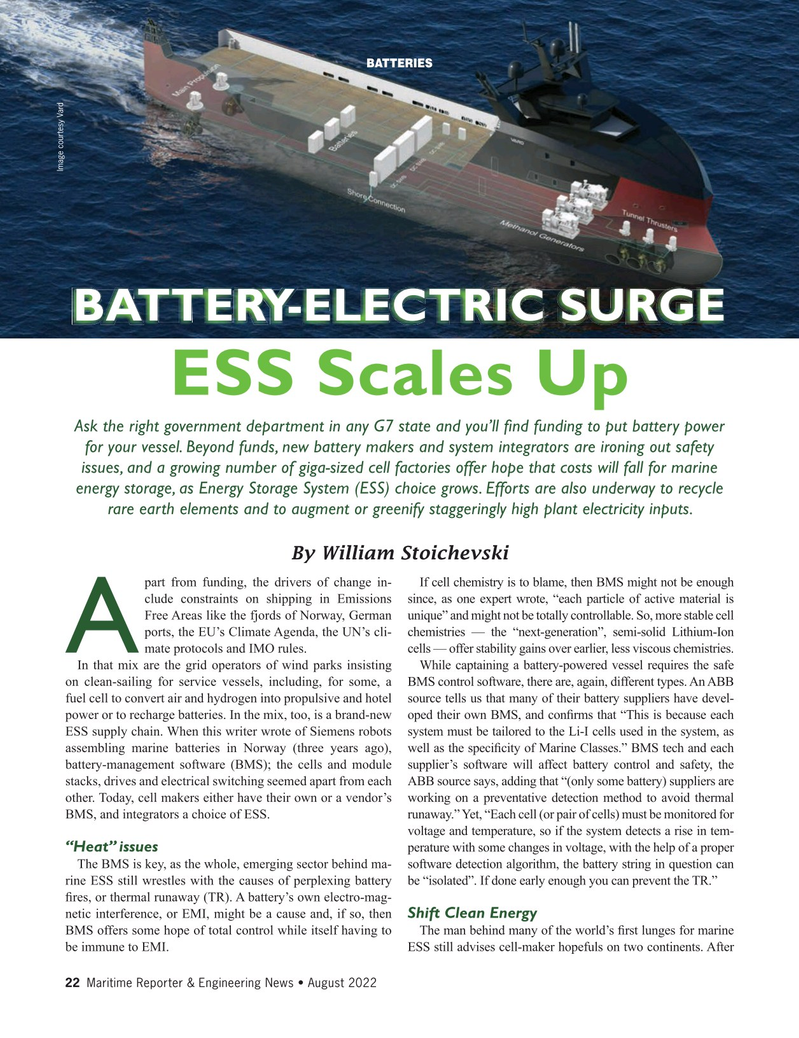
Page 22: of Maritime Reporter Magazine (August 2022)
The Shipyard Annual
Read this page in Pdf, Flash or Html5 edition of August 2022 Maritime Reporter Magazine
BATTERIES
Image courtesy Vard
BATTERY-ELECTRIC SURGE
ESS Scales Up
Ask the right government department in any G7 state and you’ll ? nd funding to put battery power for your vessel. Beyond funds, new battery makers and system integrators are ironing out safety issues, and a growing number of giga-sized cell factories offer hope that costs will fall for marine energy storage, as Energy Storage System (ESS) choice grows. Efforts are also underway to recycle rare earth elements and to augment or greenify staggeringly high plant electricity inputs.
By William Stoichevski part from funding, the drivers of change in- If cell chemistry is to blame, then BMS might not be enough clude constraints on shipping in Emissions since, as one expert wrote, “each particle of active material is
Free Areas like the fjords of Norway, German unique” and might not be totally controllable. So, more stable cell ports, the EU’s Climate Agenda, the UN’s cli- chemistries — the “next-generation”, semi-solid Lithium-Ion mate protocols and IMO rules. cells — offer stability gains over earlier, less viscous chemistries.
A
In that mix are the grid operators of wind parks insisting While captaining a battery-powered vessel requires the safe on clean-sailing for service vessels, including, for some, a BMS control software, there are, again, different types. An ABB fuel cell to convert air and hydrogen into propulsive and hotel source tells us that many of their battery suppliers have devel- power or to recharge batteries. In the mix, too, is a brand-new oped their own BMS, and con? rms that “This is because each
ESS supply chain. When this writer wrote of Siemens robots system must be tailored to the Li-I cells used in the system, as assembling marine batteries in Norway (three years ago), well as the speci? city of Marine Classes.” BMS tech and each battery-management software (BMS); the cells and module supplier’s software will affect battery control and safety, the stacks, drives and electrical switching seemed apart from each ABB source says, adding that “(only some battery) suppliers are other. Today, cell makers either have their own or a vendor’s working on a preventative detection method to avoid thermal
BMS, and integrators a choice of ESS. runaway.” Yet, “Each cell (or pair of cells) must be monitored for voltage and temperature, so if the system detects a rise in tem- perature with some changes in voltage, with the help of a proper “Heat” issues
The BMS is key, as the whole, emerging sector behind ma- software detection algorithm, the battery string in question can rine ESS still wrestles with the causes of perplexing battery be “isolated”. If done early enough you can prevent the TR.” ? res, or thermal runaway (TR). A battery’s own electro-mag- netic interference, or EMI, might be a cause and, if so, then
Shift Clean Energy
BMS offers some hope of total control while itself having to The man behind many of the world’s ? rst lunges for marine be immune to EMI. ESS still advises cell-maker hopefuls on two continents. After 22 Maritime Reporter & Engineering News • August 2022
MR #8 (18-33).indd 22 8/1/2022 10:19:12 AM

 21
21

 23
23
